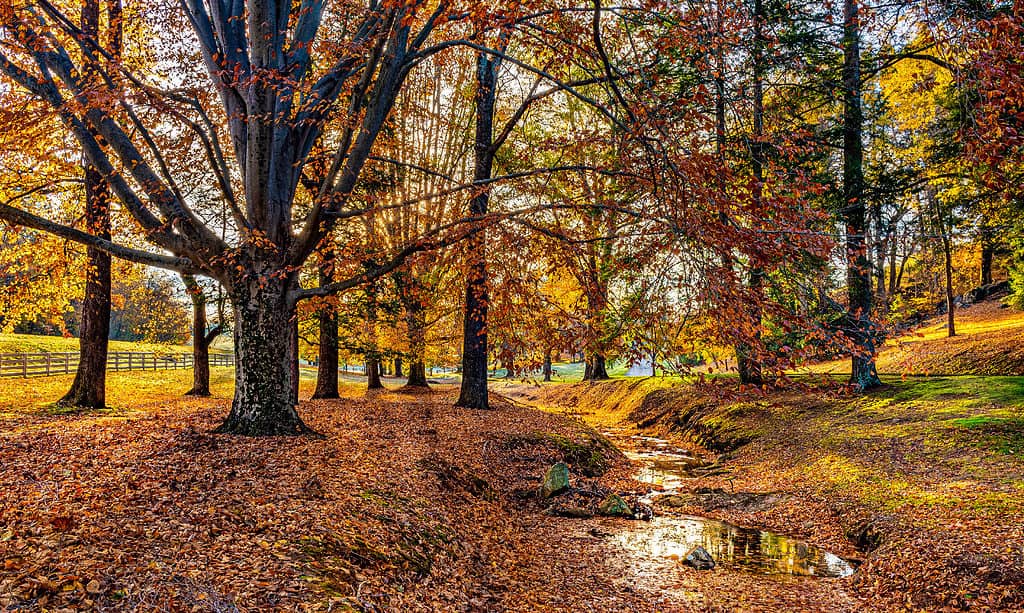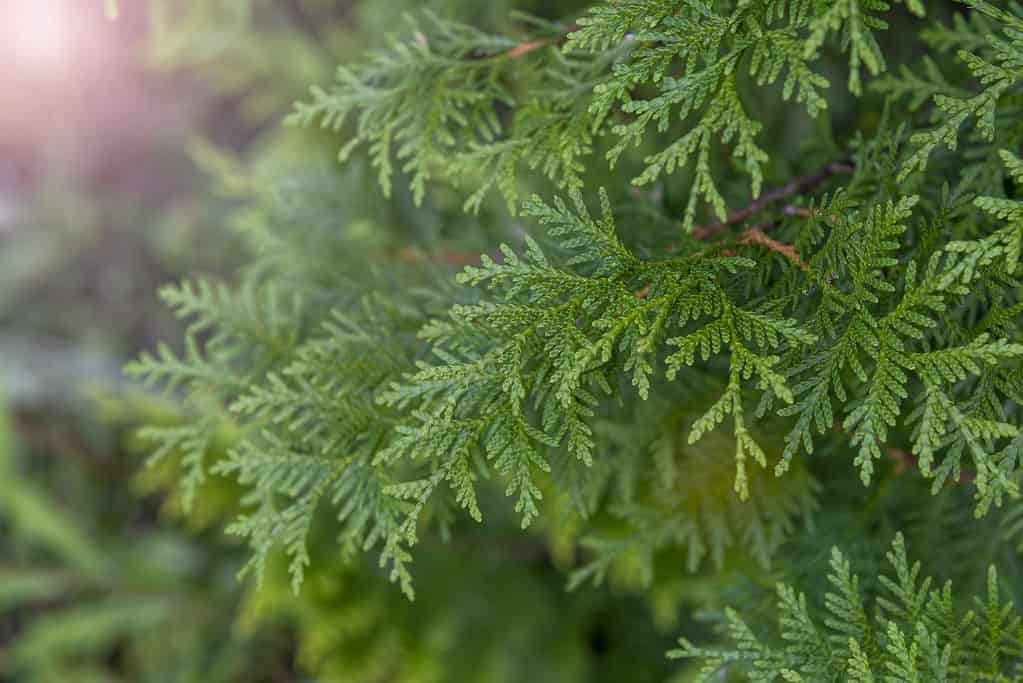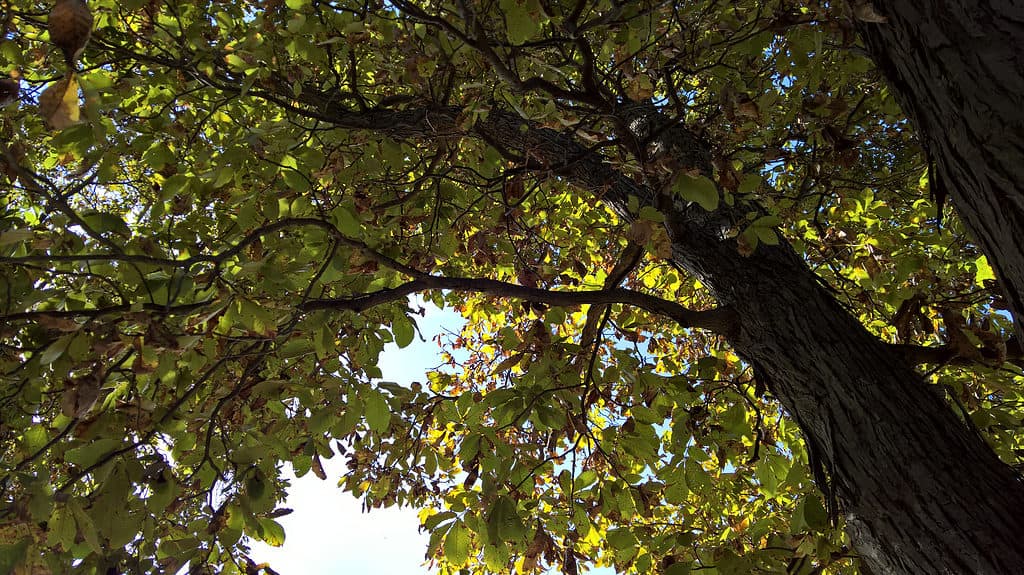Michigan has a continental climate with warm summers and cold winters. Precipitation is generally moderate throughout the year, although it is heaviest in the late autumn and early winter. The geography and topography of Michigan can be described as flat, with low-lying hills and plains. Michigan has more than 75 native trees!
Trembling Aspen
Trembling aspen (Populus tremuloides) is a small tree with many names. Some of its nicknames include quaking aspen, mountain aspen, white poplar, and golden aspen. It typically grows to around 30 feet in height but can reach 80 feet with perfect growing conditions. It has smooth, light-colored bark that is streaked with black.
It is characterized by its distinctive green glossy, trembling leaves that turn yellow in the fall. Aspen trees are highly adaptable and can be found in a variety of habitats, from open fields to shady forests.

©iStock.com/Timon Schneider
American Basswood
Tilia americana is also called American linden. It is a large, deciduous tree that is native to Michigan. It typically grows to 60-120 feet and can live up to 200 years. It has a thick trunk that can reach up to five feet in diameter when fully grown.
American basswood is known for its large leaves that can be four to six inches wide and up to ten inches long. The leaves are dark green and shiny and turn yellow in the fall. It has tiny fragrant flowers that produce downy cream-colored fruits. These fruits provide nectar for insects and bountiful food for chipmunks and squirrels. Caterpillars love to eat the leaves, and even rabbits benefit by eating their bark.

©Alina Vaska/Shutterstock.com
American Beech
American beech (Fagus grandifolia) is a medium-sized deciduous tree native to Michigan. It typically grows to heights of around 50-70 feet and can live up to 150 years. It is characterized by its smooth, grey bark and glossy, dark green leaves, which turn yellow in the fall. Beech trees prefer moist, well-drained soils and are often found in wooded areas.

©Gerry Bishop/Shutterstock.com
Yellow Birch
Yellow Birch (Betula alleghaniensis) is a medium-sized tree native to Michigan. It typically grows to heights of around 52-115 feet and can live up to 100 years.
It is characterized by its distinctive yellowish-gold exfoliating bark that is curly and nearly translucent. The yellow birch has bright green leaves, which turn yellow in the fall. If you scratch the bark, it gives off a delightful winter-green scent!

©iStock.com/Chantale Ouellet
Black Gum
Blackgum (Nyssa sylvatica) is a medium-sized deciduous tree native to Michigan. It has many nicknames and is often called the black tupelo or sour gum. There are many types of tupelos, some of which grow in swamps and some in the uplands of central Michigan.
It typically grows to heights of around 66-82 feet and can live up to 650 years! It is known for its reddish-brown bark that turns dark brown with age. The bark is furrowed and scaly. It has dark red winter buds, oval leaves, and yellow-green flowers in the spring. After it flowers, it produces fruits that are like dark blue stones.
Deer love to eat the leaves of this tree. The flowers provide rich nectar for insects, and the fruits feed birds and mammals. It has a trunk that makes a wonderful home for various nesting animals and bees.

©Photo by David J. Stang, CC BY-SA 4.0 <https://ift.tt/dWwkhjG>, via Wikimedia Commons – License
Northern White Cedar
Thuja occidentalis also goes by eastern white cedar and arborvitae. It is a small, evergreen tree that is native to Michigan. It typically grows to 25-35 feet, though its fully mature height can be up to 50 feet. It is a long-lived tree and can grow for 100 years. You can recognize it easily by its furrowed red-brown bark that peels in narrow strips. It has small seed cones that are yellowish green, distinctive fan-like branches, and scaly leaves.

©iStock.com/Andrey Rykov
Sweet Crabapple
Sweet crabapple or wild crabapple (Malus coronaria) is a small bushy shrub or small tree native to Michigan. It typically grows to heights of around 20-30 feet and can live up to 50 years. It has a wide open crown, fragrant fruit, and red-brown fissured bark.
It is characterized by its bright red winter buds and rose-colored flowers in the spring. The small yellow-green apples are less than two inches in diameter and have a strong apple scent.

©Cbaile19, CC0, via Wikimedia Commons – License
Flowering Dogwood
Flowering dogwood (Cornus florida) is a small deciduous tree that is native to southern Michigan. It is also called American dogwood, Florida dogwood, Indian arrowwood, and several other names. It typically grows to heights of around 15-30 feet and is usually wider than it is tall when fully grown.
It loves the hot, humid summers in Michigan, which help harden off new growth when fall comes. These trees live for about 80 years and will delight you with a show of flowers in April or May. The flowers are small and green-yellow with bracts of red, pink, or yellow. You can find flowering dogwoods in the wild at the edges of forests or growing on dry ridges.

©iStock.com/michaelmill
Common Hackberry
Hackberry (Celtis occidentalis) is a medium-sized deciduous tree that is native to Michigan. It is otherwise called nettletree, sugarberry, and beaverwood. It is a beautiful hardwood tree with light-colored wood and cork-like bark with warty bumps.
This unique tree produces small reddish-orange fruits that turn purple in the fall. It is often planted for winter interest in the garden because these lovely fruits can stay on the tree for many months. Hackberries grow 30-50 feet tall and have round tops. They prefer rich, moist soil but can adapt to rocky or gravelly soil if they must.

©iStock.com/Nahhan
Bitternut Hickory
The bitternut hickory or swamp hickory (Carya cordiformis) is a grand tree native to Michigan and can be found in the eastern half of North America. It typically reaches heights of 50-115 feet with a trunk diameter of one to three feet.
This deciduous tree has long, pinnate leaves that are 6-12 inches long, each composed of 7-11 leaflets. The bark is light gray and scaly on young trees but turns darker and more furrowed as it matures. The flowers are long catkins that hang from the tree in the spring and are blown and pollinated by the wind.
The fruit is a very bitter nut, but the seeds and bark are eaten by wildlife. Rabbits, in particular, enjoy the seeds. The wood of the butternut hickory is often used for smoking and making furniture and tool handles.

©Plant Image Library from Boston, USA, CC BY-SA 2.0 <https://ift.tt/m4OsZRo>, via Wikimedia Commons – License
Pignut Hickory
Pignut hickory (Carya glabra) is also called the sweet pignut, coast pignut, smoothbark hickory, and broom hickory, among others. It grows wild in the lower peninsula and can be found on dry ridgetops and slopes. It is highly adaptable and will grow in mountainous, moist, or sandy sites.
Pignut hickories have leaves that turn yellow in the fall and a lovely pear-shaped nut that ripens in autumn and smells like maple. This nut is an important food for various animals, including squirrels, turkeys, bears, foxes, rabbits, and raccoons. Deer love to eat its leaves, twigs, and nuts.

©Plant Image Library / Flickr – License
Shagbark Hickory
Shagbark hickory (Carya ovata) is another grand tree native to Michigan, the eastern United States, and Canada. This large deciduous tree can reach towering heights of over 100 feet and a ripe old age of 350 years! They are easy to spot because of their gorgeous shaggy bark hanging off the tree in long strips after it ages.
Shagbark hickories have catkin-like flowers that look like long stalks and edible nut fruits. The nut has a hard shell and a thick green husk that turns darker as it matures.
As you can guess, these nuts are prized by squirrels, raccoons, chipmunks, and mice and make up a good portion of their diet. They are also eaten by bears, foxes, rabbits, ducks, and turkeys.
Humans can also eat these nuts, which make a great pecan substitute. The wood of shagbark hickory is often used for smoking and making tools like axles, handles, plows, and drumsticks.

©iStock.com/Ethan R.
Here is a Summary of 12 Trees Native to Michigan
- Trembling Aspen
- American Basswood
- American Beech
- Yellow Birch
- Black Gum
- Northern White Cedar
- Sweet Crabapple
- Flowering Dogwood
- Common Hackberry
- Bitternut Hickory
- Pignut Hickory
- Shagbark Hickory
Up Next
- European Beech vs. American Beech: What’s the Difference?
- Mountain Lions in Michigan
- 9 Native Plants in Colorado
The post 12 Grand Trees Native to Michigan appeared first on AZ Animals.
from Animal News, Facts, Rankings, and More! - AZ Animals https://ift.tt/QhFk2Ii